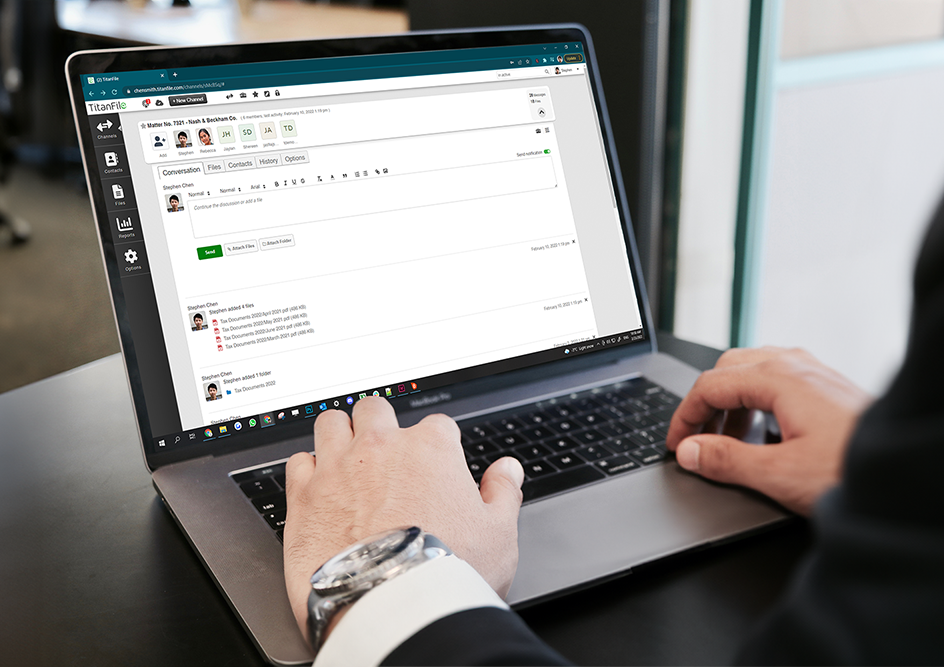As an IT director, you must have seen it all: lawyers sending case files as email attachments, staff dropping evidence on USB sticks and mailing it to one location from another or clients asking for a Dropbox or Google Drive link for easy file access. Are these file sharing practices convenient? Of course! But are they secure and compliant? Not even close. Every unsecured file transfer is a headline waiting to happen.
With lawyers working across time zones, gigabytes of eDiscovery files moving daily and compliance rules getting stricter with every passing day, even one slip costs millions. That’s why forward-thinking IT leaders are rewriting the playbook and looking for law firm file sharing best practices that help them to implement secure file sharing for law firms, protect client confidentiality, reduce IT bottlenecks and stay ahead of stringent regulations.
In this guide, we will discuss the most common challenges IT directors face in legal file sharing and outline the legal document sharing best practices that every IT director should know.
IT Director’s Challenges in Legal Document Sharing
Unlike other organizations, legal IT teams face issues that are not so common in other industries. Law firms handle extremely sensitive client data such as case files, contracts, medical records and financial information, where a single mishandling can result in lost cases, regulatory fines or reputational damage to the firm. Legal IT directors are constantly under pressure to balance security, compliance and usability in their firms.
The following are some of the most pressing challenges that legal IT directors face on a daily basis:
Unsecure File Sharing Methods Increase Cybersecurity Risk
Outdated file sharing methods like emails, FTP servers, USB drives and cloud sharing are still widely used in many law firms. These legacy file sharing tools create vulnerabilities, including interception, misdelivery and loss of physical media. Even with encrypted email service add-ons, IT leaders struggle to enforce firm-wide adoption, leaving sensitive documents exposed to security breaches.
Shadow It and Fragmented Solutions
When official tools are clunky and hard to use, lawyers often turn to consumer-grade file sharing solutions like Dropbox, Google Drive or WeTransfer. While these tools are convenient and easy to use, these platforms lack the compliance and security safeguards required for legal file sharing, creating governance gaps and “blind spots” for IT teams. Shadow IT not only undermines security but also complicates the audit trails for digital forensics when a security incident happens.
High IT Workload and Bottlenecks
In the absence of firmwide secure file sharing solution, IT help desks often bear all the burden. In such cases, attorneys depend on the IT team to upload, compress or send large files on their behalf, which creates workflow delays. This reactive support model uses resources that IT directors want to invest in important projects like cybersecurity, automation, and digital transformation.
Compliance Complexity Across Multiple Jurisdictions
Attorneys share their case files and documents between different jurisdictions all the time. During these transfers of details between different areas, it has to be ensured that they follow all the compliance regulations for that particular region. In law firms, each client may demand to adhere to different compliance standards, making compliance management a difficult task for IT teams. In such situations, IT directors have to make sure that every document transfer is secure, encrypted and logged while also ensuring that the data resides in the correct jurisdiction.
Hybrid Work and Remote Collaboration
After the global pandemic, most organizations have adopted a remote and hybrid work environment, and law firms are no exception. It is a challenging task for IT directors to provide security on remote devices for defence against growing cyber threats like phishing and ransomware without compromising the ease of use and flexibility. Remote teams need tools that balance flexibility with secure client collaboration at all times.
Client Trust and Reputational Risk
Client trust is everything for law firms. Clients share their most sensitive information with lawyers because they put their trust in them and have faith that confidentiality will be maintained no matter what. A single data breach can jeopardize this and result in losing long-standing client relationships. IT directors take on the responsibility to ensure that their firm’s legal document sharing practices reinforce law firm data security. When that doesn’t happen, they lose client trust, and this affects the firm’s reputation.
Challenge of Disconnected Platforms
Law firms heavily rely on Document Management Systems (DMS), Outlook, Microsoft Office Suite, SIEM (Security Information and Event Management) tools, and other case management software. For IT directors, ensuring that a new tool integrates seamlessly into the existing work system without creating duplicate workflows or points of friction can be challenging.
Legal Document Sharing Best Practices
Legal document sharing best practices are not just about the platform or technology but its more about creating a secure, compliance and efficient workflow to move the confidential information inside and outside the firm. These following legal file sharing tips will help IT directors to strengthen the large file transfers within their firm, reduce security risks and create a smooth experience for both their staff and clients.
Standardize on a Secure, Enterprise-Ready Platform
IT directors need to make sure that everyone in the firm uses a standardized secure file sharing solution that supports AES-256 encryption, granular access control, audit logs, and multi-factor authentication. Because though free consumer tools are easy to use and convenient, they lack the basic security features and compliance. A standardized platform for secure legal file sharing ensures compliance while reducing IT risk.
Reduce IT Burden by Enabling Self-Serve Access
Lawyers shouldn’t be dependent on the IT desk to send out large files. Deploying a self-serve file-sharing solution in your firm empowers staff to collaborate securely without IT intervention. Self-serve access also makes it easy to collaborate with external users and stakeholders.
Ensure Compliance Across Jurisdictions
Law firms often work across borders and share key case details and files. In such cases, it is important for IT directors to ensure that data residency aligns with client and regulatory requirements. For all-around compliance, select a file-sharing service that is ISO 27001 and SOC 2 certified, PIPEDA, HIPAA, and GDPR compliant, and also offers custom data residency options in different regions. IT directors must prioritize compliance in legal document management to satisfy varying client and regulatory demands.
Leverage Granular Access Controls and Audit Logs
When the same documents are shared with multiple people, it is important for IT directors to maintain visibility and accountability. Granular access ensures that only the right people can access sensitive files, and audit logs track who accessed and downloaded the file, and when. Detailed audit trails not only strengthen accountability but also support audit trails legal compliance during investigations.
Support Large File Transfers Without Bottlenecks
Litigation and eDiscovery often involve multi-gigabytes of data that traditional email systems can’t handle. Adopting a platform built for secure file transfer for law firms prevents costly delays during litigation and eDiscovery. A legal document sharing best practice is to adopt a platform that offers secure file transfers without file size or type restrictions and with fast transfer speeds. This will prevent delays in court submissions and remove roadblocks in client communications.
Integrate With Existing Legal Tech Stack
When a new tool integrates seamlessly with the existing platforms that lawyers already use, adoption rates increase without hassle. A tool that offers the familiarity with email through Outlook integration, DMS integration for seamless matter-based collaboration, and APIs for advanced workflow automation is the perfect fit for legal document sharing.
Balance Security With User Experience
Firm-wide adoption of a secure file sharing tool depends on ease of use. If the tool is clunky or difficult to navigate, lawyers and clients will refuse to use it, ultimately undermining the IT director’s efforts. Since attorneys are used to working with email, it is best to choose a solution that is just as easy to use as email. This minimizes resistance and reduces the need for training. The tool should also support mobile access to accommodate hybrid work environments and remote client collaboration. Ease of use should never compromise security; instead, solutions should align with document sharing security best practices that lawyers and clients can trust.
IT Director’s Role in Driving Secure Adoption
Forward-thinking IT directors are already excelling in the legal document sharing space by adopting smart, secure file transfer solutions. But implementing a secure file-sharing platform is only the first step. The real challenge arises when they have to ensure firm-wide adoption and embed legal document sharing best practices into daily workflows. That means creating clear governance policies, setting access controls, and building a culture where secure collaboration is the default, not a choice.
Successful IT directors achieve this by reducing the friction within their firm. Choosing an easy to use platform increases the adaptability between the lawyers and minimizes the dependency on IT helpdesk. For example, Marshal Dennehy an Am Law 200 firm rolled out a TitanFile’s secure file sharing solution in their firm and gave them self-access access to share the confidential documents with clients. Within months, turnaround times improved with lower support tickets and it led to higher client satisfaction. From this it is clear that adoption improves when security is balanced with user experience.
“ The TitanFile team was excellent in ensuring that we had a smooth transition onboarding 1200 employees. When we initially introduced the product to our employees, they found the platform easy to access, easy to use, and reliable. The positive feedback from our staff convinced us that TitanFile was the solution for us. ”
– Karen Swift, Director of Information Technology
Finally, IT directors need to show ROI to firm leadership. Fewer support tickets, quicker document turnaround and reduced compliance incidents prove that secure file sharing is not just only about reducing risk but also about improving productivity, increasing efficiency and protecting the firm’s reputation amongst clients. With easy to use tools, governance and measurable results, IT directors can set the standard for secure collaboration in the legal industry.
Setting the Standard for Secure Legal Collaboration
For law firms, IT directors implementing the legal document sharing best practices are more than just about security and compliance, it’s about safeguarding the client trust, protecting their firm’s reputation and enabling their staff to work with maximum efficiency.
With standadized secure platforms, reduced IT bottlenecks, detailed audit trails and industry compliance, IT directors can set their firm for a long-term success.
If you are an IT director looking to simplify secure collaboration, now is the time to put these legal document-sharing best practices into action. The right platform should guarantee ironclad security, reduce the IT helpdesk burden, make compliance easy and effortless, and keep your lawyers free from technology hurdles.
Want to see what that looks like in practice? Book a personalized walkthrough to explore how IT leaders from leading law firms are achieving it, or start a hassle-free trial today to test it with your team.
Legal File Sharing FAQs
What are legal document sharing best practices for IT directors?
Legal document sharing best practices include standadizing file sharing through out the organization, ensuring compliance and regulations like ISO 27001, SOC 2, HIPAA, PIPEDA, and GDPR, using granular access control, leveraging detailed audit logs, and balancing the security with ease of use.
Why can’t law firms rely on consumer file sharing platforms like emails, Google Drive or Dropbox?
Though traditional file sharing platforms like emails are convenient and easy to use but they lack the security and encryption legal industries need to share sensitive confidential information. There is also a high risk of security and data breaches while using these tools.
How can IT directors reduce the file sharing burden on their IT help desk?
IT directors need to introduce a self-serve secure file-sharing tool for their law firm that is easy for attorneys and staff to use to send large files securely without relying on the IT help desk to do it for them.





